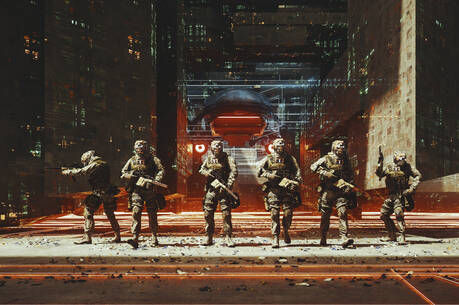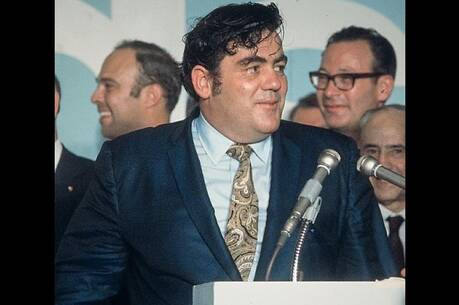The 'Secret Encyclical'
John LaFarge, S.J., is one of the best known Catholic advocates for racial justice in the 20th century. Born to an aristocratic family in Newport, R.I., in 1880, Father LaFarge graduated from Harvard in 1901 and then traveled to Austria, where in 1905 he was ordained and joined the Jesuit order. He worked for several years on a Jesuit mission in southern Maryland and then moved to New York, where he became an editor of the Jesuit weekly America. During this time, Father LaFarge came to be convinced that racism was the result of ignorance rather than, for instance, the result of adherence to dogmas of racial inferiority. He accordingly advocated a gradualist response to the race problem that focused on education. In 1937 Father LaFarge summarized his views in a book entitled Interracial Justice: A Study of the Catholic Doctrine of Race Relations.
Though LaFarge’s book was primarily aimed at an American audience, it was well received across the Atlantic. The reigning Pope Pius XI (1922<\!a>39) was so impressed by the text that in the spring of 1938 he asked the American Jesuit to prepare a draft encyclical on the unity of the human race. Doubtless, Pius XI’s concern with race was exacerbated by events on the European continent. Since 193, the pope had been hearing about Germany’s “war of destruction against the Jews” from Edith Stein, a convert from Judaism, whose pleas for papal intervention, however, received no official response. In 1937, Pius XI issued a partly theological, partly political condemnation of Nazi Germany, through the encyclical Mit Brennender Sorge. Though the text tackled the issue of Nazi racism, it tellingly stopped short of a full denunciation, condemning only its most extreme forms. The following year, Pius XI admitted that there was “room for special races” and that “some races are more fitted and others less gifted”—arguments that considerably undermined the promise of a full Catholic turn against racism.
At the same time, however, the pope engaged the American John LaFarge and asked him to write an extended exploration of Catholic attitudes toward race. The Jesuit—who agreed with the pope and most of the people in the Vatican at the time that Communism, not Nazism, posed the greater threat to the church’s survival—welcomed the prestigious assignment. After having asked the Jesuit superior general for assistance, LaFarge traveled to Paris, where he collaborated with the German Jesuit Gustav Gundlach and the French Jesuit Gustave Desbuquois. The three men toiled away for several months, sworn to absolute secrecy. The resulting draft encyclical, titled “The Unity of the Human Race,” argued that because of the existence of one natural law and one Creator, the human race was also one. Ten pages were dedicated to the Jews, including a section justifying the church’s right to protect itself against the “active hostility of the Jewish people to the Christian religion,” and yoking Jews to the promotion of “revolutionary movements that aim to destroy society and obliterate from the minds of men the knowledge of God.”
As the journalist Peter Eisner narrates in a new, engrossing narrative history, the work of Father LaFarge, Gundlach and Desbuquois never saw the light. By the time the draft encyclical reached Pius XI on Jan. 21, 1939, the pope was on his deathbed; when Eugenio Pacelli (Pius XI’s secretary of state) became Pius XII on March 2, 1939, he chose to keep the encyclical secret. Only in 1963 did John LaFarge—in the final year of his life—share the remarkable story of the secret encyclical with fellow Jesuits at the residence of the editors of America in Manhattan. The story went public in 1969 and has since been the object of several newspaper articles, doctoral theses and scholarly monographs.
The most recent addition to this literature is Eisner’s colorful account, The Pope’s Last Crusade: How an American Jesuit Helped Pope Pius XI’s Campaign to Stop Hitler. An editor and reporter at The Washington Post, Newsday and the Associated Press, Eisner’s previous monographs have focused on the history of U.S. intelligence prior to the U.S. invasion of Iraq and on the heroic rescue of a downed Allied plane by French resistance fighters. This latest book does a fine job bringing the central characters to life by reporting a flurry of conversations and letter exchanges.
The book adds little that is new, however, to the major interpretations already available in the scholarly literature. Concurring with the authoritative work on the topic by Georges Passelecq and Bernard Suchecky (The Hidden Encyclical of Pius XI), Eisner argues that LaFarge and Pope Pius XI were groundbreaking clerics, ahead of their times; their strong opposition to racism in all forms was silenced by Pope Pius XII and a group of conservative churchmen within the Vatican, who worried about the potential effects such a revolutionary statement might make.
Eisner’s history thus squarely situates itself (without saying so explicitly) within the Pius wars, which have been raging for the better part of 40 years. The debate revolves around the relationship of Pius XI and, more important, Pius XII to Nazi Germany and the Holocaust. As one well-established line in the literature has it, Pius XI opposed the Nazis, while Pius XII, out of caution or conviction, did not get in the way of the imposition of the Nazi new order. From the time of its discovery in the late 1960s, the secret encyclical has been, for evident reasons, a central element in the debate surrounding the papacy’s relations with European Jewry between World War I and World War II.
Eisner’s account sides with the defenders of Pius XI and the accusers of Pius XII and oversimplifies some important historical nuances. First, Pius XI had a more ambiguous relationship to Judaism and racism than Eisner allows, as a close reader of Mit Brennender Sorge and Pius XI’s subsequent statements on German racialism is forced to conclude. Second, it is a mistake to assume that John LaFarge’s somewhat enlightened views on white-black relations in the United States (for an important corrective, see David W. Southern, John LaFarge and the Limits of Catholic Interracialism), would translate into a defense of Judeo-Christianity. As the historian John Connelly has reminded us in his important recent book From Enemy to Brother: The Revolution in Catholic Teaching on the Jews, 1933-1965, even the watershed Vatican II statement on Jewish-Christian relations was, in the 1960s, highly contested and the result of heated internal debates.
In the years between World War I and World War II, staunch Catholic defenders of the equality between Jews and Catholics were few and far between, and most came from the margins of the Catholic world (many, in fact, were Jewish converts), rather than from the institutional centers of power. Judged by the standards of the works on race that these Catholics were writing in the 1930s, Pius XI’s statements, and John LaFarge’s unpublished encyclical, appear cautious, antiquated and tinged with a variety of Catholic anti-Judaism that had for centuries been an accepted doctrinal view. Eisner may well be right to sing LaFarge’s praises, but he should be wary of doing so without properly situating LaFarge within his historical context, and without taking into account the considerable differences in approach between the Catholic Church in the United States and the European churches to the knotty question of race in the interwar years.
This article also appeared in print, under the headline “The 'Secret Encyclical',” in the April 22, 2013, issue.









